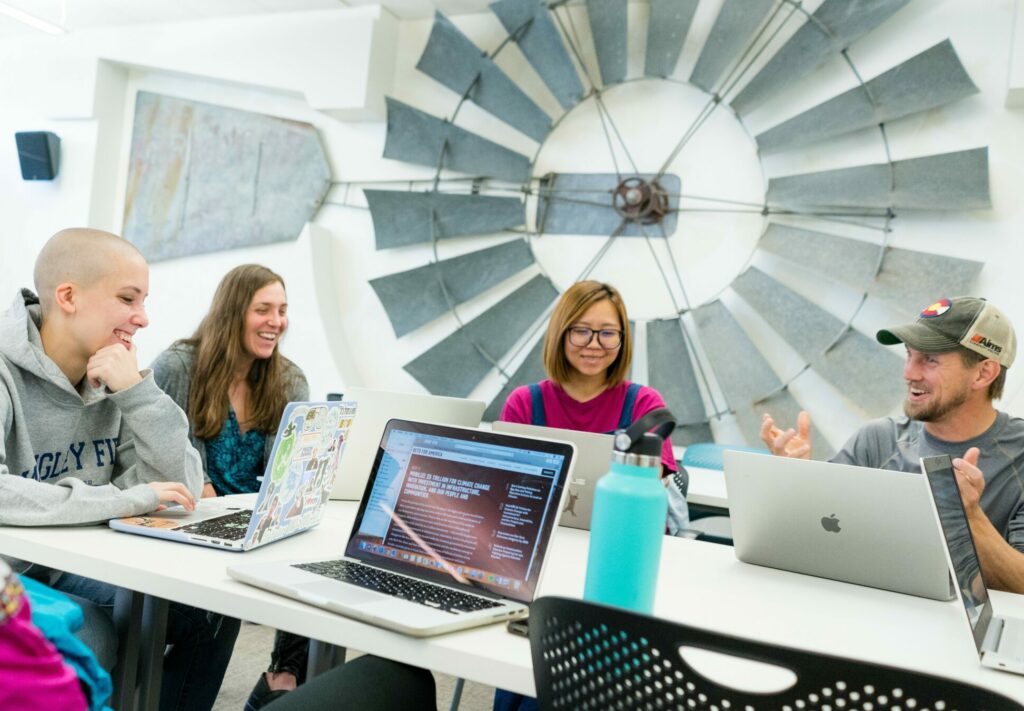Welcoming and Inclusive Environment
Classroom climate is fundamentally an interpersonal experience which regulates the learning experience and is established whether you are intentional about it or not. Students feel more invested in the class and their learning if they feel like they belong and are a member of a learning community that cares about them and their ideas. “In terms of college, sense of belonging refers to students’ perceived social support on campus, a feeling or sensation of connectedness, and the experience of mattering or feeling cared about, accepted, respected, valued by, and important to the campus community or others on campus such as faculty, staff, and peers (Strayhorn, 2019, p. 5)”. Social support and your actions (and the actions of students’ peers) should signal to students that they belong..
Welcoming Space 
The following suggestions will help you be intentional about creating the climate you desire – one that supports all students in their learning. Research indicates that students appreciate co-constructing the learning environment.
- Believe in students and that they can succeed. Communicate this with them.
- Learn students’ names and pronounce them correctly. Address students by name and consider using name tents in large classes.
- Introduce yourself and consider sharing your pronouns. Use students’ preferred pronouns if they offer them.
- Be aware of the CSU Principles of Community and make them a foundation of your class. Work with students to create class/community norms and establish a system to adhere to them.
- Connect the content to the lived experiences of all students.
- Add a diversity statement to your syllabus.
- Honor student identities and culture. Some students prefer not to make eye contact or shake hands. That does not mean they are not interested in connecting with you or their classmates.
- Incorporate CSU Principles of Community into your class.
- Check for student understanding and reteach if necessary.
- Create an inclusive environment.
- Be vulnerable; tell students when you don’t know something, and find out for next class.
- Ask students for feedback specifically on your class climate. Act on that input. Share with students what you are doing, why, and how you hope it impacts your class climate.
- Ask students for feedback on your teaching several times a semester; do something with their feedback.
- Visualize what you want your class to look like… Feel like… Sound like… take small steps each semester to make it a reality.
- Smile. Breathe. Use humor if that fits your teaching personality. (Make sure humor does not call attention to any specific race, culture, gender or other stereotypes.)
Strategies to Support Students 
The following are strategies you can use to support students’ sense of belonging in your course:
- Tell students outright that they belong.
- Some students experience imposter syndrome. Your affirming comments and support for their learning lets them know they deserve to be in your class. Take their questions seriously. Consider if you are inadvertently sending signals that might be interpreted as a confirmation of their status as an imposter.
- Incorporate activities that build a community of learners so that all students feel like they belong in your class.
- Identify microaggressions and confront them. Refer to your class norms or the CSU Principles of Community as needed.
- Be sure your content represents contributions from a wide range of backgrounds so that all students can see themselves as belonging to the discipline.
- Do not ask individuals to speak for an entire group of people.
- Make content accessible for all learners.
Additional Considerations for Teaching Online
While most of the information on teaching effectiveness pertains to both RI and online classrooms, following are a few key points for online courses.
Set up your online class to aid your students in being successful:
- The most basic way to increase success in your course is to ensure that students can find your content. If materials are consistently and logically organized, students can focus on learning the course content rather than on finding material in the course. Review Break your content into units, and use Modules to guide your students to set up modules in Canvas.
- As you create your modules, review use Student View often, to see how your course works for your students.
- Along the same lines of course and module organization, make sure your files are in order within the learning management system (LMS). See Organize and prepare your course Files for more information.
- The navigation links in the LMS are to the left of the screen and guide students to items such as modules, announcements and assignments. Review Select your Navigation Links to set these up in your course.
- The lack of visual or other in-person cues in online interactions can lead to misunderstandings and failure to respect social norms. Give students an explicit guide to constructive online interactions, such as Netiquette: Ground Rules for Online Discussions, or develop a netiquette guide with your students.


